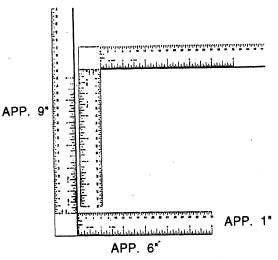Figure 8-11.—Cropping L’s.
the form of a rectangle, you can adjust them and see the
effects of cropping before a crop is actually made.
takes place. The measurement usually is given by
columns: two columns, three columns, and so on. You
must know the standard width of the column and alley
and the space between the columns (one pica,
one-eighth inch, and so on) to get an accurate
reproduction width.
You will use the three known dimensions (cropped
width, cropped depth and reproduction width) to
determine the unknown dimension, usually the
reproductive depth.
REPRODUCTION DEPTH (RD).— T h e
reproduction depth is the number of inches the
photograph will be after it is enlarged or reduced to fit
in the space allotted for it on the newspaper page.
On occasion, you may set aside a vertical space to
fill on your newspaper page design. In such a case, you
are using the cropped width, cropped depth and
reproduction depth to establish the unknown
reproduction width. This reverse procedure is used
frequently in photo layouts where standard column
widths may not apply.
Photograph Dimensions
SCALING
Before you can scale a photograph (explained later),
you normally have to know the following three
dimensions:
l Cropped width
l Cropped depth
l Reproduction width or reproduction depth
CROPPED WIDTH (CW).— The cropped width
is the width of the photograph, in picas, columns or a
local unit of measurement, after cropping is completed
In scaling photographs and artwork, width is usually
represented in picas, columns or the local unit of
measurement. Width is not usually represented in inches
because most other horizontal measurements in
newspaper design are in picas, columns or a local unit
of measurement (such as ciceros).
CROPPED DEPTH (CD).— The cropped depth is
the depth of the photograph after cropping has been
completed. Depth is usually represented in inches, not
picas or columns.
REPRODUCTION WIDTH (RW).— T he
reproduction width is the actual width of the photograph
for reproduction. This is the predetermined space
allotted for the photograph before cropping or scaling
Scaling is the act of either enlarging or reducing a
cropped photograph or artwork to fit a hole on a
newspaper page. Since you must first know the cropped
dimensions, you cannot scale a photograph before you
crop it. Once you know the dimensions, then you can
scale the photograph to fit that hole snugly.
In scaling a photograph, you are trying to determine
either the reproduction depth or the reproduction width.
As you enlarge or reduce the photograph to reproduction
width, the reproduction depth will change
proportionately. Consequently, when you scale for
reproduction depth, the reproduction width will change
proportionately.
The two simple ways to scale a photograph or
artwork to size areas follows:
l The diagonal method
l The proportional scale method
The Diagonal Method
The diagonal method of scaling a photograph or
artwork is a mechanical procedure that does not require
great mathematical skill or special tools. Diagonally
8-13


